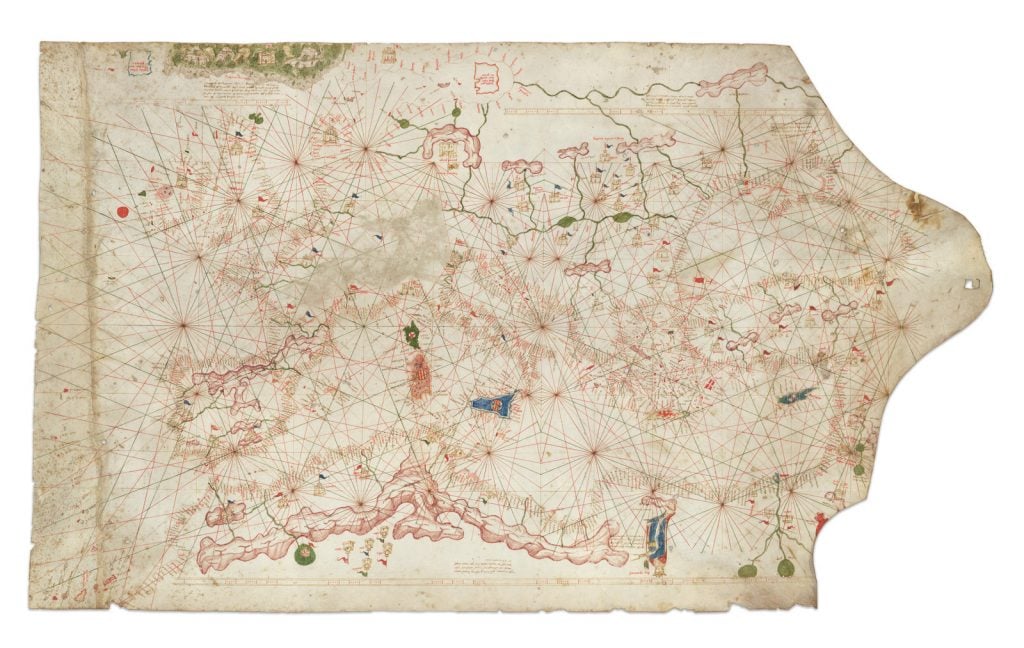Auctions
A Nautical Chart Sold at Auction for $239,000 Is Revealed as the 4th Oldest of Its Kind and Is Now Tagged at $7.5 Million
The map depicts the waterways of the Mediterranean and beyond.

The map depicts the waterways of the Mediterranean and beyond.

Richard Whiddington

As estate sales of the über-wealthy go, the Ann and Gordon Getty Collection sell-off at Christie’s last year was a major success. Across 2,300 sold lots, it netted $200 million for charity, set a record for a Mary Cassatt painting, and saw major museums and collectors jostling for masterpieces of fine and decorative art.
One lot, however, was a major blunder, at least from the perspective of Christie’s.
That was a vellum nautical map, known as a portolan chart, depicting the waterways of the Mediterranean and beyond, its red rhumb lines reaching into the North Atlantic and stretches of the Eurasian Steppe. Christie’s labelled the “idiosyncratic” and “unusual” map as early 16th century and gave it a $100,000 to $150,000 estimate.
But Alex Clausen, a San Diego map dealer, sensed something older, rarer, and potentially far more valuable while browsing the auction house’s digital catalog.
A crescent flag hovers over southeastern Spain, signifying the presence of a Moorish kingdom that wouldn’t be defeated until 1492. The borders of mainland Europe are convoluted, suggestive of a time before the conclusion of the Hundred Years War. Curious, too, are the lingering Crusader strongholds yet to be ejected from the Levant.
Christie’s suggestion of 1500 to 1525 seemed off, not by decades, but by centuries. Clausen suspected the chart had been drawn in the early 1400s, but conversations with scholars and catalogers pushed the date back to the mid-1350s.
Another oddity was Christie’s suggestion that the portolan chart was “undoubtedly produced for display for a wealthy Genoese client.” In fact, all evidence pointed to Genoa’s great maritime rival Venice. Oversized emphysis was given to Venice and its colonies in Crete and Venetian vernacular for island, ixola, was used sporadically.
When it came up for auction in October 2022, Clausen, together with his team at the map dealers Barry Lawrence Ruderman, bought it for $239,000. It would prove something of a once-in-a-lifetime acquisition.
Following the purchase, Clausen sent it to a New York lab to back up historical inference with scientific proof. Pigment analysis and carbon dating showed the chart had been made sometime between the 1320s and 1420s.
Barry Lawrence Ruderman settled on 1360 and calls it the Rex Tholomeus Portolan Chart, in honor of the 2nd-century geographer Ptolemy who appears in the bottom right as a crowned and red gowned figure. Christie’s mistook him for King Solomon.
It’s the fourth oldest surviving portolan chart of Europe, the oldest being the Carta Pisana from the late 13th century, which is held by the national library of France. The asking price now is $7.5 million, another category of collecting altogether and one that will likely remain framed on Clausen’s office wall until a university or museum decides to take ownership of it.
In the meantime, scholars are lining up to write the definitive essay on the portolan for International Journal for the History of Cartography. “We have talked to many niche subject matter experts about how this chart impacts their work,” Clausen said. “I’m particularly interested in hearing from people outside the map world for their insights.”
More Trending Stories:
Four ‘Excellently Preserved’ Ancient Roman Swords Have Been Found in the Judean Desert